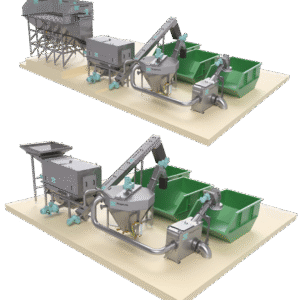Description
Noggerath® Sewer Grit Receiving Station is designed to receive mixtures of organics, solids and water collected by specialised vehicles that wash surface water pipes and streets.
Many European cities are facing the major challenge of stormwater pollution. Sand, gravel, dirt, tree leaves and other debris are constantly being carried from the street into the surface water pipeline with rainwater and aftershocks. These debris accumulate over a long period of time, clogging the pipeline and disrupting the smooth functioning of the surface water system, increasing the risk of flooding. Many wastewater network operators are now forced to use specialised vehicles to wash pipes and vacuum up the accumulated debris. As surface water management involves cleaning of collection wells and pipelines, sand and oil traps, settling basins and soil disposal, traditional tanker emptying methods face several challenges:
- Insufficient separation capability. With large volumes of contaminants, it is difficult for traditional methods to effectively separate different materials.
- Environmental problems. Some of the materials that tankers dump into waste sites or concrete settling ponds can cause environmental pollution and odour problems.
- Problems with the handling of different types of material. Solid materials can be left without proper treatment and dewatering, raising questions about their safe handling.
The Aqseptence Group solution
Aware of these problems, engineers from the Aqseptence Group have designed and developed the Noggerath® Sewer Grit Receiving Station, which is revolutionising the way we approach the treatment of surface wastewater systems. This unique three-stage system allows:
- With a protected receiving hopper to efficiently receive a mixture of gravel, sand, sludge, organics and water from tankers and the ability to provide the necessary security at this critical point.
- Separating coarse materials: with Noggerath® drum screen RSH-I for separating solids from liquids and the possibility to adapt them to the different types of materials to be screened, the volumes to be screened and the working conditions. With Noggerath® SpiralConveyor SC for transporting separated coarse materials into the container.
- Sand cleaning: With the Noggerath® grit washing unit GWC, designed to leach organic matter from sand and gravel and to not only reuse the leached sand but also to save on waste transport and storage costs.
Each Noggerath® sewer grit receiving station is tailored to the site-specific conditions, materials and volumes. This allows for an efficient and individual solution to the different challenges of surface water drainage systems in each different city.






